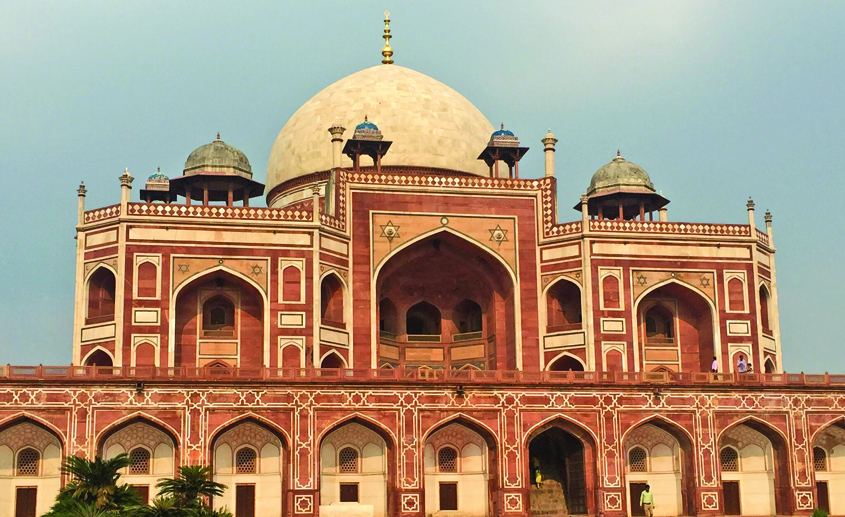 Historically, mosque and tomb architecture offer finest examples of medieval Islamic building activities, drawing upon various kinds of styles and influences. Humayun’s Tomb in Delhi is one such monumental and shining endeavour. Declared as UNESCO World Heritage Site in 1993 and located in close proximity to a place sacralised by the blessings or barkat of the presence of the foremost Chishti Sufi saint, Hazrat Nizamuddin Auliya, the huge, grand yet elegantly and delicately built monument is a sight to behold. The Agha Khan Trust for Culture, Archaeological Survey of India, South Delhi Municipal Corporation and the Central Public Works Department have come together in a remarkable collaboration called Nizamuddin Urban Renewal Initiative, as part of a people-public-private enterprise, to restore and preserve the magnificence of this fine Mughal tomb complex built in the 16th century, along with other architectural marvels in the vicinity surviving from the medieval era.
Historically, mosque and tomb architecture offer finest examples of medieval Islamic building activities, drawing upon various kinds of styles and influences. Humayun’s Tomb in Delhi is one such monumental and shining endeavour. Declared as UNESCO World Heritage Site in 1993 and located in close proximity to a place sacralised by the blessings or barkat of the presence of the foremost Chishti Sufi saint, Hazrat Nizamuddin Auliya, the huge, grand yet elegantly and delicately built monument is a sight to behold. The Agha Khan Trust for Culture, Archaeological Survey of India, South Delhi Municipal Corporation and the Central Public Works Department have come together in a remarkable collaboration called Nizamuddin Urban Renewal Initiative, as part of a people-public-private enterprise, to restore and preserve the magnificence of this fine Mughal tomb complex built in the 16th century, along with other architectural marvels in the vicinity surviving from the medieval era.In his finest and mid-19th century work on Delhi’s monuments, called Aasar-us-Sanadid, or architectural heritage as evidence of past grandeur, Sir Syed Ahmad Khan mentioned that Humayun’s Tomb was built by his wife Haji Begum; some 15 lakh rupees were spent in completing the project in about 16 years, that is, sometime in the year 1572. As a precursor to the Taj Mahal at Agra, the Tomb stands on a huge platform and serves as an important early example of Persian influence in Indian architecture, for which especially trained craftsmen were invited from Iran, backed by a strong Timurid connection of the Mughals.
According to Catherine Asher, one of the foremost historians of Mughal architecture, the Mughals were extremely proud of their Timurid ancestry, and it is not without significance that this Timurid-inspired tomb and setting continued to serve as an important model for imperial tombs in decades to come. And, as another leading scholar of medieval architecture, Ebba Koch has noted: Mughal imperial ideology and their fabulous artistic practices, including monuments and paintings, are inextricably linked to each other in terms of highlighting their power and resources.
As a family graveyard, containing over 150 graves and earning it the sobriquet of “Dormitory of the Mughals”, the structure is built of rubble masonry, using red sandstone and white marble in large quantities. The canopies on the terrace were covered in glazed blue tiles, with a six-metre long brass finial glittering from the top of the 42.5-metre high double dome clad in white marble. The gardens below with connected water channels and fountains sought to imitate the spectacular beauty of the gardens of heaven, supported by some finely carved Quranic verses on the marble cenotaph.
The exquisite monuments such as the ones at Humayun’s Tomb, Qutub Minar complex, Tughlaqabad, Purana Qila—with archaeological evidence taking the site back to the antiquities of the time of Indraprastha of Mahabharata fame—Firozshah Kotla and the city of Shahjahanabad together highlight the great Indian historical achievements through the medieval and early modern eras. Though power is now concentrated in 20th-century Lutyens’ Delhi, the ramparts of the 17th-century Lal Qila still remain the site for emotional expressions of India’s power, grandeur and humility in a manner typical of Indian confidence tempered with modesty.
The aberrations of anarchic times notwithstanding, these magnificent monuments will continue to inspire awe. It should also encourage those in power to not only preserve these enormous marvels, but also build further—on a newer site the 9th or 10th city of Delhi and leave a mark of their grand vision for enduring future appreciation. Even as celebrations on the recent declaration of six-century-old medieval city of Ahmedabad as India’s first World Heritage City by the World Heritage Committee of UNESCO are somewhat dampened by the devastating floods, it is time to push for Delhi’s nomination and claims for a similar status, with longer historical antecedents of its resilient power and splendid grandeur. Otherwise also, a walk around Delhi’s medieval monuments is a rejuvenating experience, offering a glimpse of a glorious past and some inspiration to leave behind something memorable for posterity.

